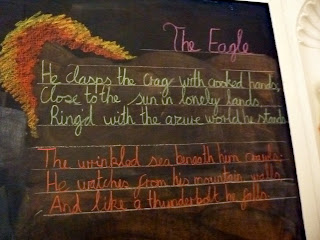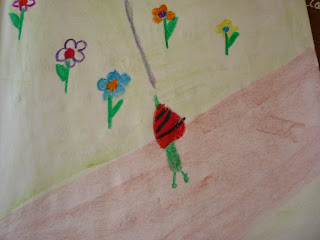
The past three weeks the class have been doing Man and Animal. As part of that they have adopted two pet gerbils. People are taking turns to bring them home over the course of the year.


The value of doing the course in anthroposphy is learning about the human being - and our relationship with animals - i mean i'm doing the course. While the children are never told directly about anthroposophy, the cirriculum does operate on its principles. I will try and write about its relevance to Class Four.
During Class Four, between the ages of 9 and 12, children enter what is described as a Golden Age. They are at the peak of childhood - beautiful, carefee, active and whole. They are remarkably co-ordinated and have this oneness with life. Parents are often shocked when their darling then metamophoses into a stroppy and sulky teenager. But that's normal too.
During Class Four also, there is a sense of 'aloneness'. The child's identity is beginning to seperate from teachers, parents and figures of authority. While they certainly still need authority, they will start to feel that they are beginning to consider what being alone is like. At this age, children often think that their parents may not be theirs. Was i adopted? What would it be like if i was left alone?
The cirriculum addresses the energy and the questions by making Class Fours WORK and by locating them in the world. Hence, doing Man and Animal. They are start doing geography and the lyre. And they now sing in German as well. Harmony is very important for Class Four, as they begin to grasp that individuals can create the whole and be part of a harmonious whole.

You can see the numbers there. I did not realise this, but Steiner insisted that children learn their tables off 'by heart' - because it helps them with their rhythm... which brings me to rhythm...
At this age (from 7 - 14) the human being is building up it's lifeforces - or etheric (which has nothing to do with ether or astral travel or anything like that). When Dylan Thomas writes about lighting 'The green fuse' he is speaking of the etheric, the lifeforce that animates the body. It has to do with circulation, breathing, cultivating habits and helping the brain develop. And rhythm helps to feed and establish the etheric.
So the practical consequence of this emphasis on rhythm in maths, is that they are excellent in their time tables, and can rhyme them off by heart, without thinking. Which also makes them brilliant at division.

Donna's drawings are really amazing now and it is so important for the children to see their teacher doing this. In order for them to do well in life in general is to see their teacher trying and improving, and in this respect they not only respect a talent when there is one, but they also see that as human beings we have a choice - we can either choose to say 'i'm not good at that' or 'do my best' and know that they are able to do this.
The children do this in a supportive environment. Each of them draws their own picture and then they are invited to walk around and say what they liked about each drawing.


For main lesson, they are doing composition and poetry.


This is a main lesson book. Once they have sketched what they want to do in their exercise books, they transfer the completed work to their main lesson book. Donna tells me that every exercise is painstakingly researched in the reference books they have in the classroom and they also keep their own dictionary, writing in words they have discovered.

They class is seated as pairs and each pair is a little team which helps each other in their research.
Although there are no tests, every day, Class Four does what is known as recall. They present to their classmates questions which they have researched and they are also asked questions. In this way, they contribute to their sum of knowledge in a collaborative way.
I had an opportunity to see this for myself in action. They took turns coming up to the front of the class and presenting/explaining their drawings. And then they asked their classmates questions and then answered them, as if they were the teachers themselves. It was really impressive seeing these nine and ten year olds having such confidence in the classroom.

They also now do borders around their essays. As the weeks go by, these get more and more complicated as the form drawing becomes Celtic knots. This teachers them symmetry as well as how to count - there are some very complicated tables involved in these intricate forms and it is amazing watching them learn it.
Form drawing helps so much in the child.
Here is a bit about it.
Form drawing, the freehand drawing of geometric shapes, is a subject taught in Waldorf schools that is not offered in most other schools. Waldorf students practice form drawing starting in first grade and continue with it through fifth grade. Later on, in sixth grade, the students learn to use a compass and straight edge to create some of the elaborate geometric shapes they once drew freehand.
Form Drawing Basics Start in First Grade
Form drawing is the very first subject taught to children in Waldorf schools when they start first grade. On the first day of classes, the children learn that every shape in the world consists of either straight or curved lines, or some combination of the straight and the curved. The teacher draws simple straight and curved shapes on the blackboard which the students first walk during circle time, then copy on paper, using the teacher’s drawing as a model. As the year goes on, the shapes become more complex. New forms are introduced with each new grade. By the time children reach fifth grade, they can draw intricately woven Celtic knots, braids, and stars that would intimidate most adults.
Drawing Integrated into Each Grade's Curriculum
The forms the children draw each year are chosen to resonate with the developmental challenges they typically experience that year and with the academic subjects they study in each grade. In fourth grade, for instance, the children learn to work with fractions and to draw geometric forms that express fractions in visual shapes. They also draw forms that relate to the cultures they are studying: forms derived from Norse art in fourth grade, when they study Norse mythology, and forms from ancient Greece and Egypt when they study those cultures in fifth grade.
Form Drawing Goals: Developing Concentration, Eye/Hand Coordination, and Focus
Like many aspects of the Waldorf curriculum, form drawing aims to help children experience abstract concepts such as wholeness with their bodies, not just with the intellect. Form drawing also aims to develop other qualities that will help the young child in school:
Concentration. The children draw slowly and with care, trying to make each shape as perfect as possible. Even simple forms require focus. It’s much harder than it looks to draw a simple circle, as the children do in third grade.
Hand/eye coordination. Drawings are copied from an example the teacher draws on the board, which requires the child to repeatedly look up at the example and back down to his or her own work.
Mastering shapes and forms that relate to letters and numbers. Many of the flowing shapes the children draw in first grade are reminiscent of the numbers and letters they will learn later in the year.
Distinguishing between left and right, top and bottom, and developing a more integrated view of the world.
Understanding how individual parts relate to the whole.
Gradual Development of Capacities is Waldorf Goal
Introducing a subject and then returning to it over and over, gradually deepening the discipline in more and more complex ways, is typical of the Waldorf approach. In form drawing, the children go from the simplest geometric shapes to mastering highly complex and sophisticated geometric forms,
Read more at Suite101: Form Drawing in the Waldorf School Curriculum: Subject Taught in Grades 1-5 to Promote Writing, Fine Motor Skills http://www.suite101.com/content/form-drawing-in-the-waldorf-school-curriculum-a81975#ixzz14bitZ9i4
Read more at Suite101: Form Drawing in the Waldorf School Curriculum: Subject Taught in Grades 1-5 to Promote Writing, Fine Motor Skills http://www.suite101.com/content/form-drawing-in-the-waldorf-school-curriculum-a81975#ixzz14bibyfUH




Here is the work on Celtic knots by some of the kids.





The dictionary they have.


















They are now sewing with great gusto and have just mastered the blanket stitch.














Here is Charlotte, the spider that lives just outside the classroom window.